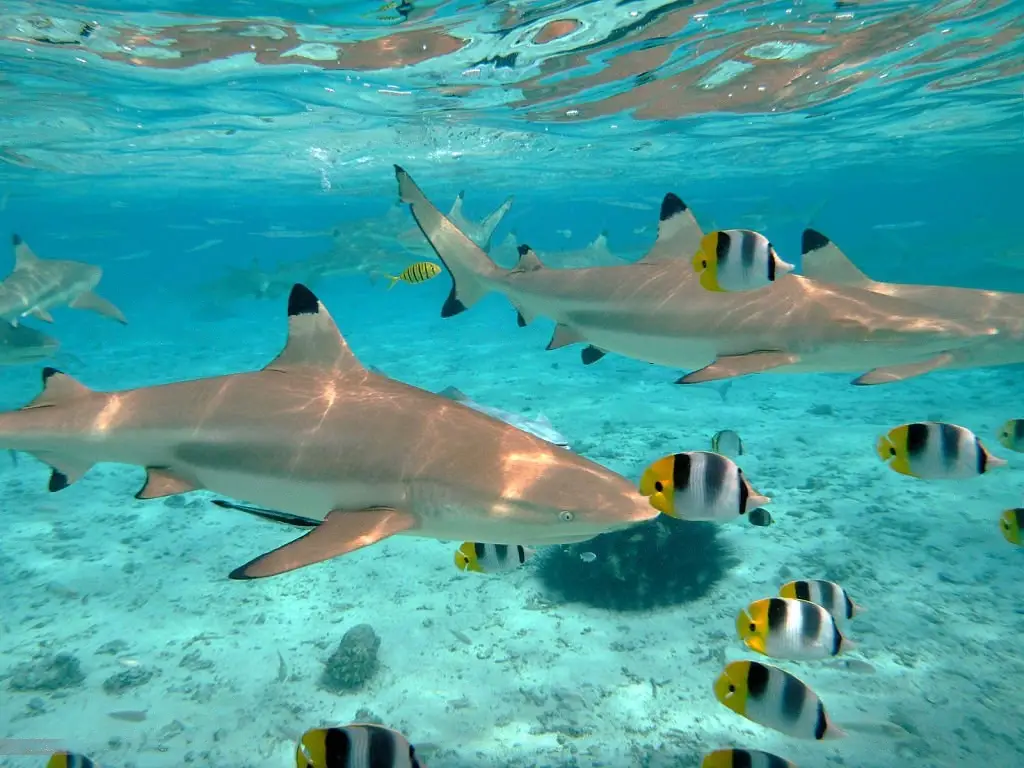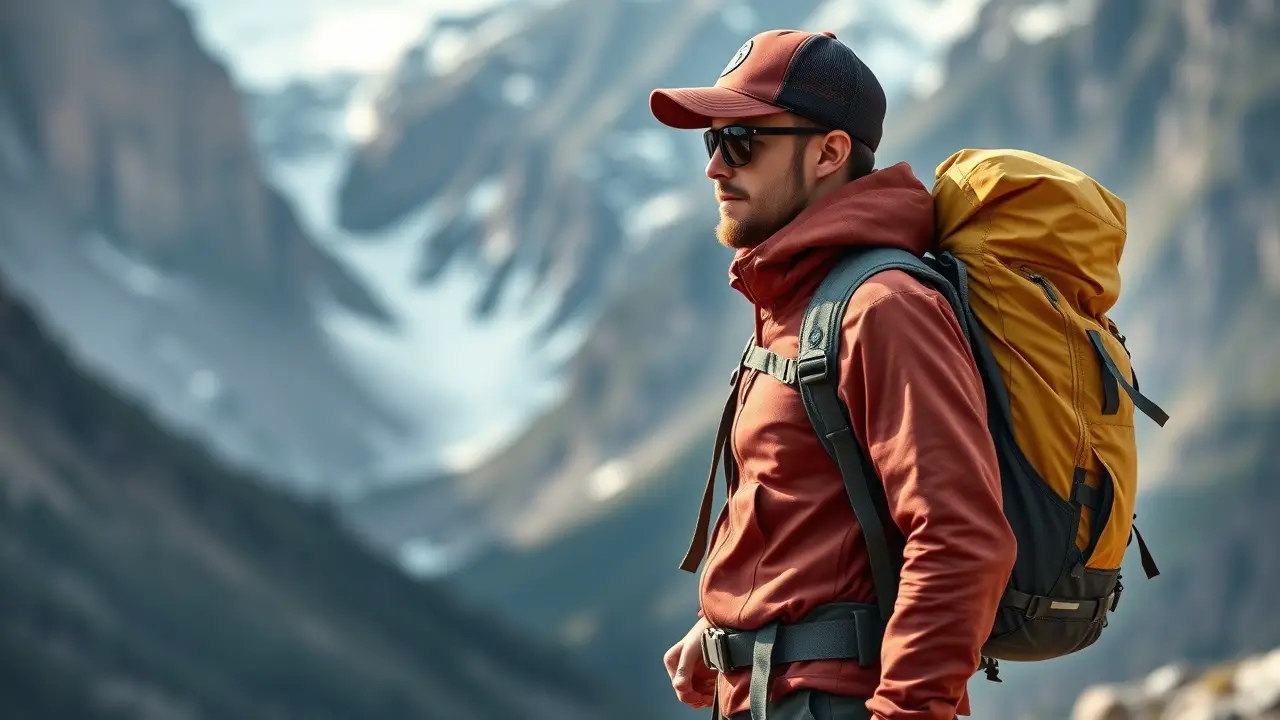Sharks in Bora Bora, the island is famous for its sharks, but not all of them are dangerous. There are several types of sharks in the lagoon, and most of them are quite friendly if you don’t provoke them!
Traveling to Bora Bora is a dream vacation for most. The stunning white sand beaches, picture-perfect blue waters, and jaw-droppingly beautiful underwater reef make it one of the most exotic places on earth.
However, when you arrive in Bora Bora on your first day of vacation, there is something else that will take your breath away: sharks!
Did you know that Bora Bora is home to a huge variety of sharks? The island boasts species like the tiger shark and even whale sharks. The warm waters around the small South Pacific island are perfect breeding grounds for these sharks.
Bora Bora, in French Polynesia (the Leeward Islands in the Society Islands), is the kind of island most people dream of. The beaches are pristine and endless, the water is crystal clear, and the islands are surrounded by corals.
These characteristics have made it a magnet for adventure seekers and divers who look forward to every opportunity they can get to experience the thrill.
Sharks in Bora Bora
Sharks are not an uncommon sight in Bora Bora. The island is home to a variety of sharks, including black-tip reef sharks, hammerhead sharks, and grey reef sharks.
If you’re lucky enough to see one, you can spot them from the shore or from above on a boat tour.
These large fish are often seen swimming in shallow water near the shoreline, but they can also be found deep down on the ocean floor.
They swim by using their tail fin to propel themselves through the water. Sharks are known for their sharp teeth, which help them catch and eat their prey.
Bora Bora is a tropical island in the South Pacific Ocean. It is part of the Society Islands and home to more than 350 different species of fish.
Among these are sharks and rays, which have become an important part of the local tourism industry.
The presence of sharks in Bora Bora has been known for centuries, but it was only recently that they became a tourist attraction. The sharks have been given names like “Big “Papillon,” and
The sharks are attracted by food offerings such as tuna heads, which they use to attract other fish.
They are also attracted by divers’ bubbles from scuba gear or free-diving snorkeling gear. It is very common for divers to see groups of up to ten sharks swimming nearby when diving near these areas.
Read more articles: Can You Take Eggs Backpacking?
Points to keep in mind
- Bora Bora shark species
- Are Bora Bora sharks dangerous?
- Why are Bora Bora’s sharks so friendly?
- How does Bora Bora shark feeding work?
- Bora Bora shark diving experience
- Sharks in Bora Bora lagoon
- Bora Bora shark and ray tours
- How do Bora Bora sharks react to visitors?
Bora Bora shark species
Bora Bora is home to a variety of species. Here are some of the most common sharks you will see in the lagoon:
Tiger shark: This species is responsible for more attacks on humans than any other type of shark, but it’s also one of the largest and most impressive sharks in the world.
In fact, tiger sharks can grow up to 20 feet (6 meters) long and weigh over 2,300 pounds (1,050 kg). They’re black above with a white underbelly, and they have large white spots along their flanks that make them look like tigers or leopards.
If you come across one while snorkeling or diving in Bora Bora’s clear waters, keep your distance! These sharks are aggressive towards humans because their natural diet includes other kinds of fish as well as sea turtles and dolphins.
Hammerhead shark: With its flat head and distinctive shape resembling an axe head (which gave rise to its name), this type has been around since prehistoric times—and it hasn’t changed much since then.
The hammerhead has two dorsal fins instead of just one; these help increase swimming speed so they can chase down prey faster than many other types of sharks found near Bora Bora Island.
Hammerheads are also known for their large eyes and small mouths, which help them see well in murky water. If you spot one of these sharks while diving in Bora Bora, keep an eye out for its distinctive shape!
Blacktip shark: With its black tips on its fins and nose, this type of shark is easy to spot in the clear waters around Bora Bora Island.
They’re also known for their aggressive behavior towards humans, which makes them a bit more dangerous than other types of sharks found in the area.
They’re named for the black tips on their fins and nose, which help them blend in with their surroundings. This shark is considered dangerous because it has been known to attack humans.
Read more articles: Taking Fresh Eggs Backpacking
Are Bora Bora sharks dangerous?
The shark is not threatening to humans. It’s not aggressive; it doesn’t display any kind of behavior that would indicate a threat, and there has never been a shark attack in Bora Bora.
In addition, sharks are highly intelligent creatures and wouldn’t want to eat something or someone that could be dangerous to them.
The most important thing to remember is that the shark is a wild animal and should be treated with respect. In general, sharks are only dangerous if provoked or threatened.
Sharks are animals that have been on the earth for millions of years. They are an important part of the ecosystem and serve as a food source for many other species.
Although sharks can be dangerous, most shark attacks are not fatal. The best way to avoid being bitten by a shark is to learn about them before going into the water so that you know how to act around them.
If you are going to Bora Bora, make sure that your hotel has shark nets around the swimming areas. These will keep sharks from being able to get close enough to attack you.
As long as you stay in these nets when swimming and avoid swimming at night, there should be no danger of a shark attack.
Why are Bora Bora’s sharks so friendly?
If you’ve ever been to Bora Bora, you may have noticed that the sharks are extremely friendly. They aren’t dangerous, aggressive, or interested in blood.
In fact, they’re not interested in human beings at all. They don’t want to eat you either—and even if they did, there’s no fish for them to eat because I’ve pretty much caught it all by now.
The sharks on this island are friendly because they have no reason to attack humans. There are no dangerous predators around these reefs, so they do not fear anything.
The local fishermen also do not hunt them and feed them with dead fish and other animals, so they feel safe here and do not harm anyone.
It is believed that sharks have evolved over time and gained more intelligence than ever before. This is why they do not attack people who come close to them without any reason or provocation.
Read more articles: Rainbow Beach in Australia
How does Bora Bora shark feeding work?
Shark feeding in Bora Bora can be done either by snorkeling or scuba diving. The most popular way is to do it while you are in the water, but it’s also possible to do it on a boat.
When feeding the sharks, you should use a net or your hands so they can grab it and eat what they need to survive.
If you see that one of them has gotten too close, then just gently push him away with your foot or hand so he doesn’t hurt himself.
You should also avoid touching the sharks, as their skin can be very rough and it’s easy to get cuts. The best way to feed them is by using your hands or a net, so they don’t injure themselves.
It’s important to remember that the Bora Bora sharks are wild animals, so if you want to feed them, you should only do so in a controlled environment.
You should also avoid touching them and don’t try to take any souvenirs from them, as they are protected by law. If you are planning your own trip, then make sure that there is someone who knows how to do this properly with you at all times.
If you are planning a trip to Bora Bora and want to see the sharks, then make sure that you go with a licensed tour operator who knows how to handle them.
Read more articles: Backpacking with Eggs
Bora Bora shark diving experience
The Bora Bora shark and ray tours are designed for those who want to enjoy the beauty of this place as well as see some of the most dangerous marine creatures on earth.
The sharks in this region are large, but they usually don’t attack people. Instead, they pose a threat to other fish and rays that swim around them.
However, if you want to dive with these animals, we recommend having some knowledge about them beforehand so that you can avoid surprising them during your dive!
How do Bora Bora sharks react to visitors?
Because these animals are wild, there is no guarantee that they’ll react positively when tourists approach them—especially if their habitat has been disturbed by humans before (e.g., by fishing).
As a result, divers must pay close attention when given instructions from their tour operator or guide in order to avoid getting too close to or disrupting any underwater ecosystems unnecessarily!
How can you tell if a shark is dangerous? It’s easy to mistake a blacktip reef shark for an aggressive bull shark, but they’re actually completely harmless.
This species lives in shallow waters and feeds on small fish and invertebrates (e.g., shrimp). They have rounded snouts, which makes them look like dolphins!
Read more articles: Snakes of Spain
Sharks in Bora Bora lagoon
You might be surprised to learn that there is a shark in Bora Bora’s lagoon. There are a few different species of sharks that can be found in the waters surrounding this island, but the most common is the reef shark.
Sharks live on every single continent except Antarctica and are very adaptable creatures; they will eat just about anything, from fish to mammals to crustaceans—and even other sharks!
Some species of sharks can even get as big as 20 feet long! The lifespan for many species is upwards of 50 years, although smaller species may only live up to 15–20 years.
Sharks have been around for over 400 million years, so they’re definitely not going anywhere anytime soon! However, despite their longevity and adaptability, sharks rarely attack humans (only three people have been killed by a shark since 1976).
But what happens when there’s an actual shark swimming around your pool at home? Well, don’t panic, because you probably don’t need to worry too much about it happening again any time soon.
The first thing to know is that sharks are very difficult to keep as pets. In fact, it’s illegal in many states and countries because they are considered protected species and can be dangerous if not properly cared for.
So, unless someone has a special permit or license to own one, it is unlikely that you will come across one at home.
The second thing is that you should never try to catch a shark in your swimming pool. If there is one there, it’s probably because it escaped from another facility or was released by someone who couldn’t keep it anymore.
Even if you were able to catch the shark (which would be very difficult), you would have no way of knowing what kind of care they need and could end up killing them accidentally.
The third thing is that you should never try to remove a shark from your swimming pool. Sharks are very strong swimmers and can move quickly through water, even if they are only 4 feet long.
Trying to grab one would be dangerous for both people and animals involved, so it’s best to leave them alone until someone with more experience can take care of the situation.
Read more articles: Snakes in Spain
Bora Bora shark and ray tours
The Bora Bora shark and ray tours are a must-do for any visitor to the island. Start by meeting up with your dive instructor in one of two locations: at Vairao Beach or on Motu Toopua.
The first location is more remote, but it has its own pros—it’s where many people go on their honeymoon. Your instructor will meet you there and lead you out into the water so that you can see some of the most colorful coral reefs in all of French Polynesia.
Afterward, head over to Motu Toopua to enjoy a delicious picnic lunch before heading back out into the water again!
While swimming around, look out for sharks who might be feeding on small fish nearby—they may even come up close enough for you to touch! This is an experience that everyone should have when visiting Bora Bora.
After your tour, head back to shore and enjoy a refreshing cocktail next to the lagoon at the Bora Bora Pearl Beach Resort & Spa’s bar.
The island is also known for its pearl farms, and you can even take a tour of some of them while staying at the resort. The lagoon is perfect for snorkeling—there are plenty of fish to see, as well as coral reefs that line much of the shoreline.
If you’re looking for a more laid-back experience, head out to the lagoon at the Bora Bora Pearl Beach Resort & Spa.
The resort has its own private beach with plenty of lounge chairs and umbrellas so that you can relax in comfort while enjoying the view.
You won’t see many tourists here—this is one of those hidden gems that most people don’t know about!
Read more articles: Seattle to Yellowstone Road Trip
How do Bora Bora sharks react to visitors?
While the Bora Bora shark is not dangerous, it is highly aggressive. This shark does not pose a threat to humans and can be easily avoided by snorkelers, divers, and swimmers alike.
The Bora Bora shark only attacks if threatened or provoked in any way, making it one of the safest sharks on earth!
The Bora Bora shark is a beautiful but dangerous shark. This species of shark is known for its large size and aggressive behavior, especially around humans.
The Bora Bora shark can grow up to 13 feet in length and weigh up to 900 pounds! The Bora Bora shark is not dangerous to humans, but it is highly aggressive.
This shark does not pose a threat to humans and can be easily avoided by snorkelers, divers, and swimmers alike. The Bora Bora shark only attacks if threatened or provoked in any way, making it one of the safest sharks on earth!
Conclusion
Snorkeling with sharks is a great experience for anyone who loves the ocean and wants to see these amazing creatures up close. The Bora Bora lagoon is a perfect place to see sharks in their natural habitat.
because it’s clear enough that you can spot them from far away. The water here is also very calm, so even if there are big waves, they won’t affect your view of the sharks!
In the end, we believe that no shark is born a bad swimmer. While it’s true that many sharks do indeed leave plenty to be desired as far as their swimming ability goes,
We feel that a bad design is an injustice to the animals and the overall community of Pacific Islanders. Perhaps better design education could have prevented these problems from arising in the first place.
At this point in time, we can only hope for a shift in perspective and a better understanding of these fascinating animals by all parties involved.
Read more articles: Best Texas State Parks for RV











Leave a Reply